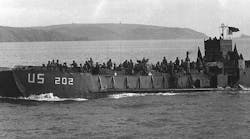During WWII, the U.S. Navy used landing craft to carry troops to the beaches. These craft were initially fitted with battery-powered electric starter motors. It is easy to understand why. They are simple to install, easy to use, and to this day they are often the default starter provided by engine manufacturers. But the Navy soon discovered a problem. The electric starter motors were not reliable. The main problem was the batteries.
Battery power is affected by temperature. The Allied landings in Europe happened during warm times of the year. The invasion of Sicily in July 1943 was closely followed by the invasion of Italy that September. High temperatures on June 6, 1944, during the D-Day landings in Normandy shortened battery life and threatened the reliability of the starting system they powered.
Weak batteries were a serious concern because there was little that could be done about it in the field. Each landing craft carried 30 to 200 troops to the beach. With enemy action taking its inevitable toll, it was essential that every craft launched successfully. It was impossible to manually recharge a battery on the water, yet it would have been equally unacceptable for a minor component like a battery to cause such a major failure.
The Navy turned to non-electric engine starting to solve its reliability problems. They used hydraulic starting systems instead of electric motors. By storing energy in hydraulic fluid, they avoided all the problems that had plagued battery-powered starters. Temperature made no difference to the hydraulic starter’s power output. If the pressure dropped it could even be topped up with a manual pump.


